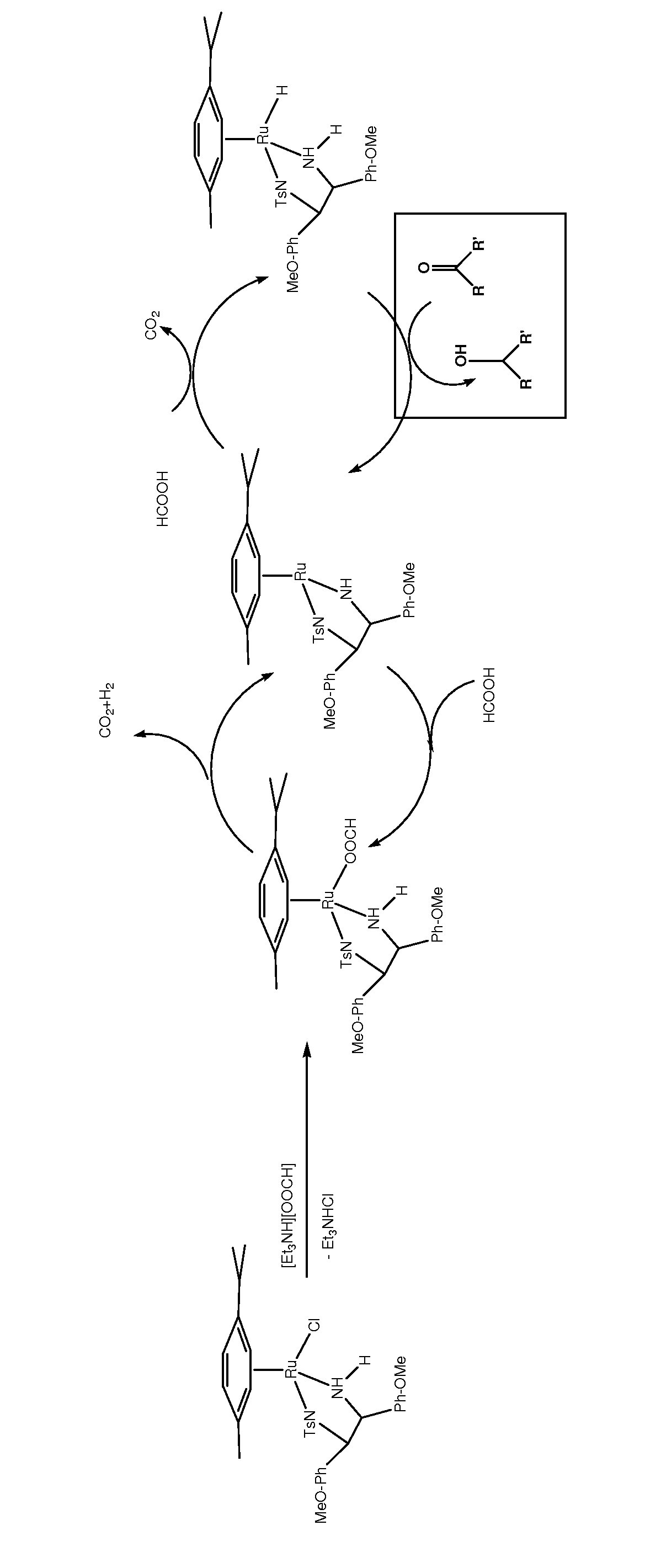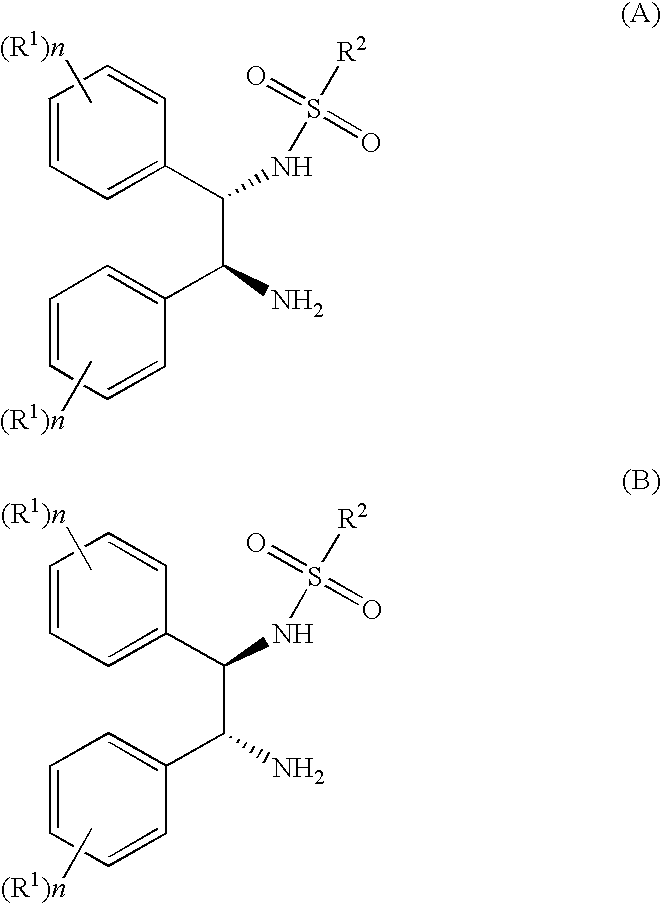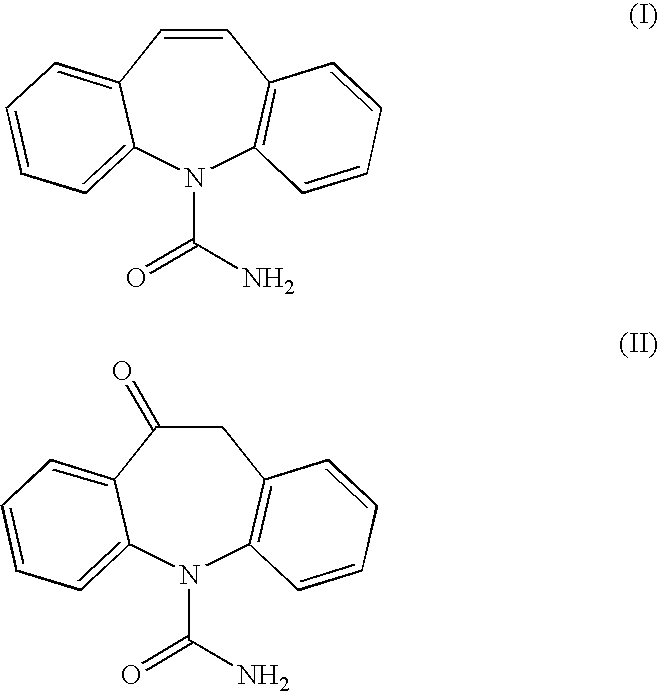Asymmetric catalytic reduction of oxcarbazepine
a technology of oxcarbazepine and catalytic reduction, which is applied in the field of asymmetric catalytic reduction of oxcarbazepine, can solve the problems of catalyst system, high cost of ruthenium catalyst, unsuitable product for use as active pharmaceutical ingredient, etc., and achieves good volume efficiency of reaction.
- Summary
- Abstract
- Description
- Claims
- Application Information
AI Technical Summary
Benefits of technology
Problems solved by technology
Method used
Image
Examples
example 1
Asymmetric Reduction of Oxcarbazepine using NEt3 and pH-Controlled Addition of HCOOH
[0079]In a 2 L 5-necked round bottom flask, oxcarbazepine was charged (635 mmol, 169 g), the flask was fitted with two water reflux condensers connected to a Schlenk line (two reflux condensers were used to secure two escape routes for CO2 and H2 gases evolving from the reaction), a burette for titration and a Hamilton gel-filled electrode fitted through a hollow GL25 screw cap equipped with a PTFE / silicone ring. To the starting material under N2 flow, EtOAc (480 mL, undegassed, HPLC grade), H2O (48 mL, undegassed, HPLC grade) and Et3N (1.1 eq., 699 mmol, 97.5 mL, undegassed, Fluka, 99.9% pure) were added with the aid of a graduated cylinder. The catalyst (formed separately in situ in a 50 mL Schlenk tube under N2 flow by stirring [RuCl2(p-cymene)]2 (0.1588 mmol, 97.2 mg) and (S,S)-TsDAEN (2.2 eq. with respect to the metal dimer precursor, 0.3493 mmol, 159 mg) in DMF (13 mL, degassed, anhydrous) at r...
example 2
Asymmetric Reduction of Oxcarbazepine Using [Et3NH][OOCH] and pH-Controlled Addition of HCOOH
[0081]In a 500 mL 4-necked round bottom flask, oxcarbazepine was charged (159 mmol, 40 g), the flask fitted with a water reflux condenser connected to a Schlenk line, a burette for titration and a Hamilton gel filled electrode fitted through a hollow GL25 screw cap with a PTFE / silicone ring. The flask was flushed with N2 for approximately 30 min. To the starting material under N2 flow, EtOAc (78 mL, degassed, anhydrous), [Et3NH][OOCH] commercially available from Fluka (1.07 eq., 170 mmol, 25 mL, undegassed, Fluka) were added via a syringe. The catalyst (formed separately in situ in a 20 mL Schlenk tube by stirring [RuCl2(p-cymene)]2 (0.0265 mmol, 16.2 mg) and (S,S)-TsDAEN (2.2 eq. with respect to the metal dimer precursor, 0.0582 mmol, 25 mg) in DMF (5 mL, degassed, anhydrous) at room temperature for 10-15 min. was injected. The Schlenk tube was rinsed with small portions of the remaining DM...
example 3
Acetylation of (S)-(+)-10,11-dihydro-10-hydroxy-5H-dibenz / b,f / azepine-5-carboxamide
[0093](S)-(+)-10,11-dihydro-10-hydroxy-5H-dibenz / b,f / azepine-5-carboxamide (500 g), obtained via asymmetric transfer hydrogenation as described above, and 4-(N,N-dimethylamino)pyridine (4 g) were suspended in dichloromethane (5.07 L). Pyridine (210 mL) was added to the suspension. The reaction mixture was heated to reflux whereupon acetic anhydride (240 mL) was added dropwise. The resulting yellowish-brown solution was stirred for 2 hours and then cooled to 30° C.
[0094]The reaction mixture was then quenched by the addition of sulphuric acid. After stirring for 10 min, the layers were separated. The organic layer was washed twice with saturated aqueous sodium bicarbonate solution and then water. Approximately half of the dichloromethane was then removed by evaporation and isopropanol (5 L) was added to the mixture which was then left to stand overnight. Further solvent was evaporated (approximately 1.5...
PUM
| Property | Measurement | Unit |
|---|---|---|
| temperature | aaaaa | aaaaa |
| temperature | aaaaa | aaaaa |
| optical purity | aaaaa | aaaaa |
Abstract
Description
Claims
Application Information
 Login to View More
Login to View More - R&D
- Intellectual Property
- Life Sciences
- Materials
- Tech Scout
- Unparalleled Data Quality
- Higher Quality Content
- 60% Fewer Hallucinations
Browse by: Latest US Patents, China's latest patents, Technical Efficacy Thesaurus, Application Domain, Technology Topic, Popular Technical Reports.
© 2025 PatSnap. All rights reserved.Legal|Privacy policy|Modern Slavery Act Transparency Statement|Sitemap|About US| Contact US: help@patsnap.com



